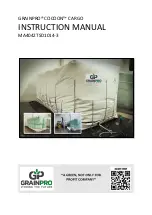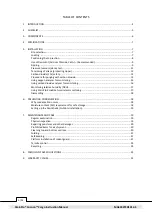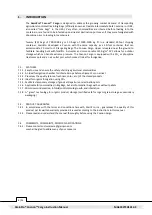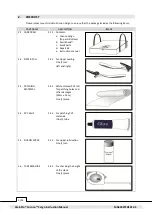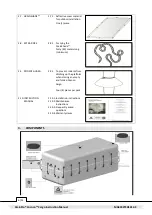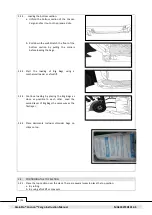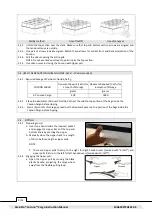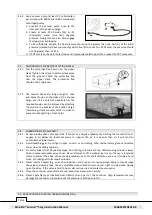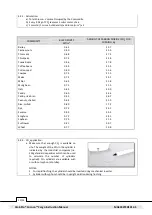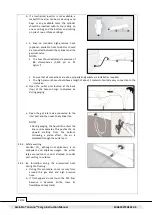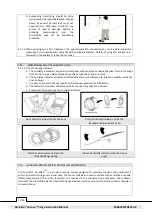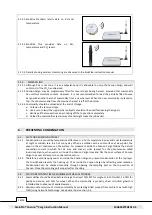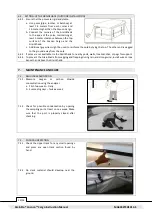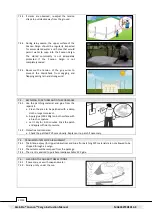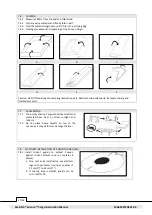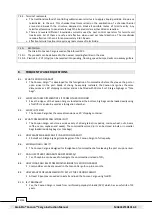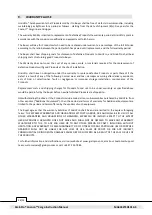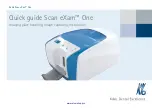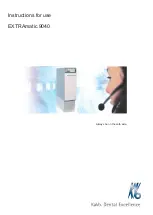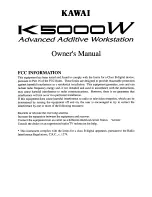
12/24
GrainPro® Cocoon™ Cargo Instruction Manual
MA4042TSD1014-3
5.6.3.
Use a vacuum pump [at least 2.3 cubic meters
per minute with 600 Watts (0.80 horsepower)
centrifugal pump]:
a.
Connect the vacuum pump hose to the
inlet port of the Cocoon Cargo.
b.
Create at least -250 Pascals (Pa) or -25
millimeters’ water (mm H
2
O) negative
pressure. Doing this can also help engage
the zipper tracks properly.
c.
To be sufficiently airtight, the final pressure should not be greater than one-half (½) of the initial
pressure (created by the vacuum pump) within five (5) minutes. For -250 Pascal, the pressure should
not be greater than -125 Pa.
d.
If PDT test fails, check for holes/tears and improperly sealed zippers then repeat the PDT procedure.
5.7.
TENSIONING OF STRAPS (PROTECTING ZIPPER)
5.7.1.
Pull the protective flap down over the zipper
track. Tighten the straps to pull any slack away
from the ground. Check the protective flap
over the zipper track. The protective flap
should not be displaced.
5.7.2.
The tension straps are long enough to raise
and apply tension to the sides of the Cocoon
Cargo, even if it is only three-quarters full. The
required tension can be achieved by attaching
the cords to the buckles of the Cocoon Cargo.
(Tensioning straps prevents folds on sides to
prevent rodent getting a tooth hold).
5.8.
CARBON DIOXIDE (CO
2
) SAFETY
5.8.1.
Carbon dioxide does not support life. It can act as a simple asphyxiant by diluting the concentration of
oxygen in air below the levels necessary to support life. As it is heavier than air it will tend to
concentrate at lower levels.
5.8.2.
Avoid breathing gas. Do not get in eyes, on skin, or on clothing. Wear leather safety gloves and safety
shoes when handling cylinders.
5.8.3.
Protect cylinders from physical damage. Do not drag, roll, slide or drop. While moving cylinder, always
keep in place removable valve cover. Never attempt to lift a cylinder by its cap; the cap is intended
solely to protect the valve. When moving cylinders, even for short distances, use a cart (trolley, hand
truck, etc.) designed to transport cylinders.
5.8.4.
Never insert an object (e.g., wrench, screwdriver, and pry bar) into cap openings; doing so may damage
the valve and cause a leak. Use an adjustable strap wrench to remove over-tight or rusted caps. Slowly
open the valve. If the valve is hard to open, discontinue use and contact your supplier.
5.8.5.
Close the container valve after each use; keep closed even when empty.
5.8.6.
Never apply flame or localized heat directly to any part of the container. High temperatures may
damage the container and could cause the pressure relief device to fail.
5.9.
PROCEDURE FOR PURGING CARBON DIOXIDE (CO
2
)

